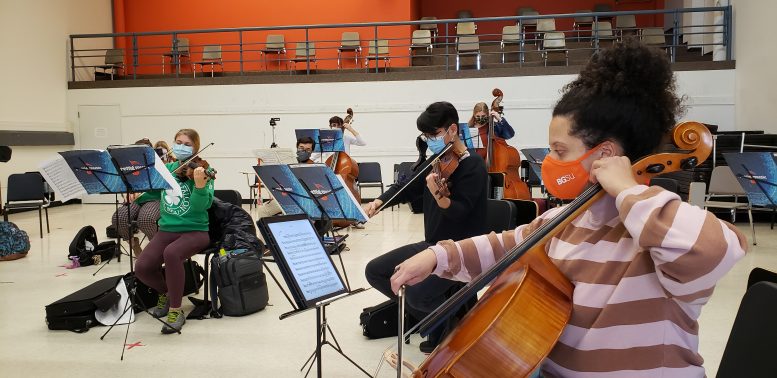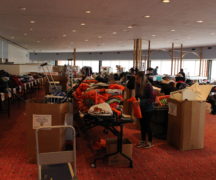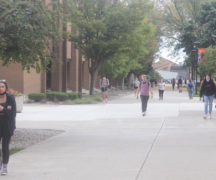By DAVID DUPONT
BG Independent News
The Wind Symphony and Concert Chorale at Bowling Green State University have come in from the cold for the spring semester.
In fall the choirs and bands rehearsed outside in tents, and were unable to perform, even virtually.
Next weekend the College of Music will present a series of live streamed performances featuring its large ensembles.
Concerts on tap are:
BGSU Wind Symphony, Friday, April 16 at 7 p.m.
Collegiate Chorale, Saturday, April 17 at 8 p.m.
Bowling Green Philharmonia, Sunday, April 18 at 3 p.m.
In fall, the Philharmonia was able to present a couple virtual performances. The orchestra was restricted to string players, all of whom wore facial coverings, and was split into two smaller ensembles.
For next weekend’s concert, Director Emily Freeman Brown will be able to bring the two ensembles together. Using a Zoom hookup, she managed to conduct the two groups rehearsing in separate halls simultaneously.
It’s just one example of the creative work-arounds she and her colleagues have made to adjust to making music during the pandemic, she said during a video posted by the Office of Marketing and Brand Strategy.
During the concert, the full string ensemble will join forces to perform “Fantasia on a Theme of Thomas Tallis” by Ralph Vaughan Williams and the last movement of “Dance Card for Strings” by BGSU alumna and Pulitzer Prize winner Jennifer Higdon. Also on the program, will be Suite for Strings by Ulysses Kay and Arioso No. 2 for Strings by Philip Glass.
Managing rehearsals, never mind, concerts, has been more difficult for singers and wind players. They don’t just breathe, they project aerosols into the environment.
Ken Thompson, the coordinator of major ensembles, said, much more is known now about how COVID-9 spreads on surfaces and in the air than in fall.
An analysis was also done on the Moore Musical Arts Center’s HVAC system.
“That gave us a better idea of what was safe and how to mitigate safely,” said Richard Schnipke, who conducts the Collegiate Chorale and Men’s Chorus. That meant bringing rehearsals, first for smaller choral groups, inside, and then beginning to rehearse in larger spaces – Kobacker Hall in the Moore Musical Arts Center and the ballroom in the student union.
That analysis revealed, Thompson said, the benefits of the extensive renovation of the HVAC system a couple years ago. “We have a very safe building.”
Not safe enough, though, to bring several dozen wind players together in one room. So in spring the Wind Symphony, which was open only to music majors, was divided into nine ensembles of nine to 16 players, including percussionists, who are able to wear masks.
These ensembles are directed by Thompson and Bruce Moss, director of band activities.
“It’s been about as safe as we can make it,” Moss said.
All rehearsals – band, orchestra, choir – are limited to 30 minutes blocks, after which the rehearsal space has to be vacated so the air can be refreshed. Students must all bring their own music stands, no longer are they sitting elbow to elbow, but instead are within their own marked out six-by-six foot square.
The music, Moss said, is a mix of new and traditional.
One piece he’s conducting is a serenade by Johannes Brahms. The British arrangement, though, substitutes a quartet of saxophones for strings.
“It’s been a very good experience for the students,” he said. “They usually don’t have the opportunity to do this kind of literature.”
The horns must also have triple-layer bell covers. That’s “catastrophic,” on pitch, color, and hearing, Thompson said.
Dealing with that is just part of their professional training, he said. In the future they may end up playing outdoor concerts, with temperatures in the high 90s, or where the temperature can be 10 degrees different at the concert than at the rehearsal.
Musicians always have to make these adjustments, he said.
The students, Thompson said, have to make the most of the situation. Five years from now, he said, no one will care that they spent part of their education during a pandemic.
Schnipke said that the situation in fall also tested his singers’ musicianship. Singing outside, spread out at six-foot intervals, and without the support of a piano, they had little to fall back on. Instead of depending on the stronger singers or the piano to find their notes, they had to spend more time in the practice room.
“I’d like to work more on that,” Schnipke said,
Back in the fall, Thompson said, once it got too cold and dark to rehearse outside in a tent, all the learning had to go virtual. One of the online modules he developed was on audition materials for military bands.
This is not typically covered in the curriculum or in lessons, but military bands offer important opportunities for musicians. A number of BGSU graduates, Thompson said, have gone on to perform in the military, most prominently Ryan Nowlin, the assistant director of the U.S. Marine Band.
Thompson wants to retain this post-pandemic.
Not all ensembles were a go. The Men’s Chorus was not offered for credit this year, Schnipke said, but it did continue as a student organization.
The director said that Dean William Mathis supported the move, allowing him time in his schedule to be advisor and hiring a pianist to accompany the ensemble.
The chorus performed a short virtual program Friday.
Two choirs that Mark Munson, director of choral activities, conducts, the A Cappella choir and the University Choral Society were disrupted.
The A Cappella choir, which is largely made up of first year students, was broken down as well into small groups with some virtual sessions. Munson plans an informal virtual showcase later in the semester.
The University Chorale Society is a town-gown ensemble created to perform the masterworks of the choral literature, often with an orchestra. The group performs both with the Philharmonia and the Toledo Symphony. It was planning to perform Haydn’s “The Creation,” but that was canceled.
So the chorale society has not met since last fall, Munson said. The choir has a performance of Mendelssohn’s “Elijah” set for spring 2022. “We’re hoping that will work,” Munson said.
Thompson believes “it will be getting closer to normal” in fall. Rehearsals may be able to run longer. But he doesn’t foresee having 80 wind players rehearse together in a one room. “I don’t think it will be normal.” Even if social distancing is reduced to three-feet, he doesn’t think that will apply to wind players.
His “gut feeling” is that there will continue to be uncertainties “because we won’t have the data on longevity of vaccines and their efficacy on the variants. Do we need a booster?”
And as has been the case for the past 13 months, “we want to be safe rather anything else.”
Schnipke said he’s hoping more choirs will be running as more people are vaccinated.
The university may offer a smaller version of its high school choir festival.
The university administration seems “hopeful,” he said. “All those decisions are made above us.”
For now the musicians are ready to culminate this unusual semester with performances.
“Goodness, everybody can’t stand not performing,” Moss said. Individual students are performing less than they normally would but “at least they’re performing.”
He added: “They really missed it. They’re ready to go at it. This is what brings them here.”
Schnipke said for the Saturday concert he didn’t plan as challenging repertoire as he ordinarily would. “I just wanted them to have a success singing and remember how great it is.”





